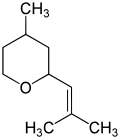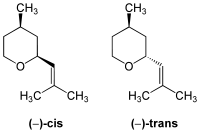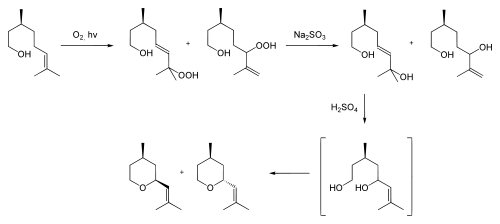Rose oxide
Rose oxide is a fragrance chemical found in roses and rose oil. It also contributes to the flavor of some fruits, such as lychee, and wines, such as Gewürztraminer.
 | |
| Names | |
|---|---|
| IUPAC name
Tetrahydro-4-methyl-2-(2-methylpropenyl)-2H-pyran | |
| Identifiers | |
| |
3D model (JSmol) |
|
| ChEBI |
|
| ChemSpider | |
| ECHA InfoCard | 100.036.763 |
| EC Number |
|
PubChem CID |
|
| UNII |
|
CompTox Dashboard (EPA) |
|
| |
| |
| Properties | |
| C10H18O | |
| Molar mass | 154.25 g/mol |
Except where otherwise noted, data are given for materials in their standard state (at 25 °C [77 °F], 100 kPa). | |
| Infobox references | |
Chemistry
Rose oxide is an organic compound of the pyran class of monoterpenes. The compound has a cis- and a trans-isomer, each with a (+)- and (−)-stereoisomer, but only the (−)-cis isomer (odor threshold 0.5 ppb) is responsible for the typical rose (floral green) fragrance.[1] The first time, in 2020 biblometric scope toward the synthesis of Rose Oxide was published. (Quantitative and Qualitative Bibliometric Scope Toward the Synthesis of Rose Oxide as a Natural Product in Perfumery)[2]
Production
Rose oxide can be produced industrially beginning with photooxygenation of citronellol to give the allyl hydroperoxide which is then reduced with sodium sulfite to provide the diol. Ring-closure with sulfuric acid forms both the cis- and trans-isomers in equal amounts.[3]
References
- Dieter Martinetz und Roland Hartwig: Taschenlehrbuch der Riechstoffe: ein Lexikon von A–Z. Verlag Harri Deutsch 1998; ISBN 3-8171-1539-3; S. 330ff.
- Ziarani, Ghodsi Mohammadi; Mohajer, Fatemeh; Jamali, Seyedh Mahboobeh; Ebrahim, Nader Ale (2020-07-22). "Quantitative and Qualitative bibliometric scope toward the Synthesis of Rose Oxide as a Natural Product in perfumery". Current Organic Synthesis. 17. doi:10.2174/1872208314666200722161044.
- Alsters, P. L.; Jary, W. .; Nardello-Rataj, V.; Aubry, J. M. (2010). ""Dark" Singlet Oxygenation of β-Citronellol: A Key Step in the Manufacture of Rose Oxide". Organic Process Research & Development. 14: 259. doi:10.1021/op900076g.

